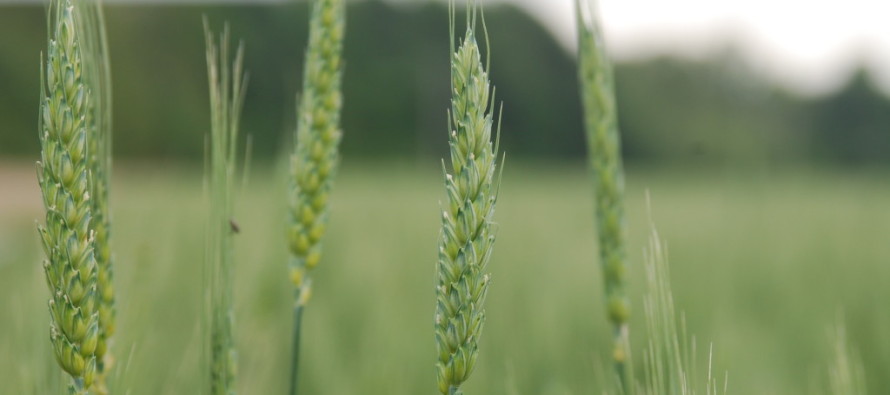Wheat Disease Update: April 24, 2015

Much of the wheat crop is extremely clean with regards to foliar disease. To date little to no stripe rust has been observed, only one location with leaf rust in some volunteer wheat plants was observed in Stoneville, and extremely limited Septoria brown spot lesions in only a few wheat fields. Generally speaking, rusts tend to present themselves once the heads emerge and at that stage applying a fungicide is at the verge of being off-label since the pre-harvest interval on most products goes until flowering (Feekes 10.5.1). However, numerous additional issues are currently being observed throughout the wheat crop in MS that appear to be related to herbicide injury as well as insect feeding rather than foliar fungal diseases. Refer to https://www.mississippi-crops.com/2015/03/29/wheat-diseases-to-be-mindful-of-during-2015/ for pictures of some of the more common wheat diseases encountered in the MS production area.
Fusarium head blight (scab) potential
Based on the predictive model (http://www.wheatscab.psu.edu/) for the better part of the past 7 to 10 days, flowering wheat throughout MS is likely at moderate (yellow) to high (red) risk of scab development. Scab development favors environmental conditions immediately prior to as well as during flowering that include rain and high levels of humidity. Historically, scab has not been a major issue in MS, but there are fields where low levels of scab have been observed over the past several seasons. But, keep in mind that the risk map ONLY presents data for the wheat currently at the flowering growth stage as flowering is the most susceptible growing stage.
Keep in mind that scab is not one of those diseases whereby you can observe the presence of the disease and then react. The scab predictive model is a useful decision-making tool that should help farmers determine, based on the location of their farm and the specific growth stage at the time of the disease prediction, if a fungicide may be beneficial. However, with that in mind, the timing of the fungicide should precede flowering to protect the developing wheat head against scab. The predictive model can be confusing since the level of risk portrayed on the map is associated with wheat that is flowering on the date in question. Wheat beyond the flowering growth stage is not susceptible to infection from the fungus that causes scab.
White, bleached wheat heads
Fusarium head blight, or scab can produce a head with either white, bleached areas in a small part of the head (more common) or a wheat head that is completely white (less common). But, one thing to key in on would be the presence of pink fungal growth that will appear wet and normally occurs between the glumes of the head (see associated photo). However, several other maladies can be confused with Fusarium head scab because they also produce a bleached wheat head:
-Wheat stem maggots will produce a completely (entire) bleached white head, but the stem will easily be pulled apart from the root by grasping the stem and gently pulling. See the attached photo exhibiting the maggot feeding at the first joint of the wheat plant as well as the entire white (bleached) wheat head.
-Glyphosate injury or drift can result in a bleached head once the head emerges from the boot. But, to positively confirm glyphosate injury look at multiple heads or multiple wheat plants to observe a range of symptoms as heads will more typically be “trapped” in the boot as a result of glyphosate injury.
-Freeze injury can result in a portion of the wheat head turning white or appearing bleached. But freeze injury has not been as common this year as it has in the recent past.
Fungicide applications
First and foremost be aware that proper disease diagnosis can be extremely important this time of year since bacterial leaf streak is a common occurrence following periods of cool, rainy weather. A fungicide will not protect a plant from bacterial leaf streak.
Over the past week to 10 days we have received numerous telephone calls regarding the necessity to apply a fungicide. Frankly, in a year when wheat prices are so low and we have had what could be considered a long, wet, cold winter, a fungicide may not be an economical decision unless disease is present or you are attempting to protect a high yield potential. Also, keep in mind that several fungicide products are labeled for scab prevention and there are some serious price differences between products. Generic fungicide products (e.g., propiconazole and tebuconazole) will likely be somewhere on the order of $4-5/acre while some more highly priced products will be on the order of $15-19/acre. In addition, be mindful that not all products labeled for application to wheat are labeled for scab and not all labeled products for scab prevention are extremely effective on the disease. Fungicide products for scab prevention are more typically fair (F), good (G), or poor (P).
A fungicide table, compiled from observations made by plant pathologists throughout the wheat producing states, can be found here (NCERA 184 Wheat fungicide table 2015).







Let me tell You a sad story ! There are no comments yet, but You can be first one to comment this article.
Write a comment